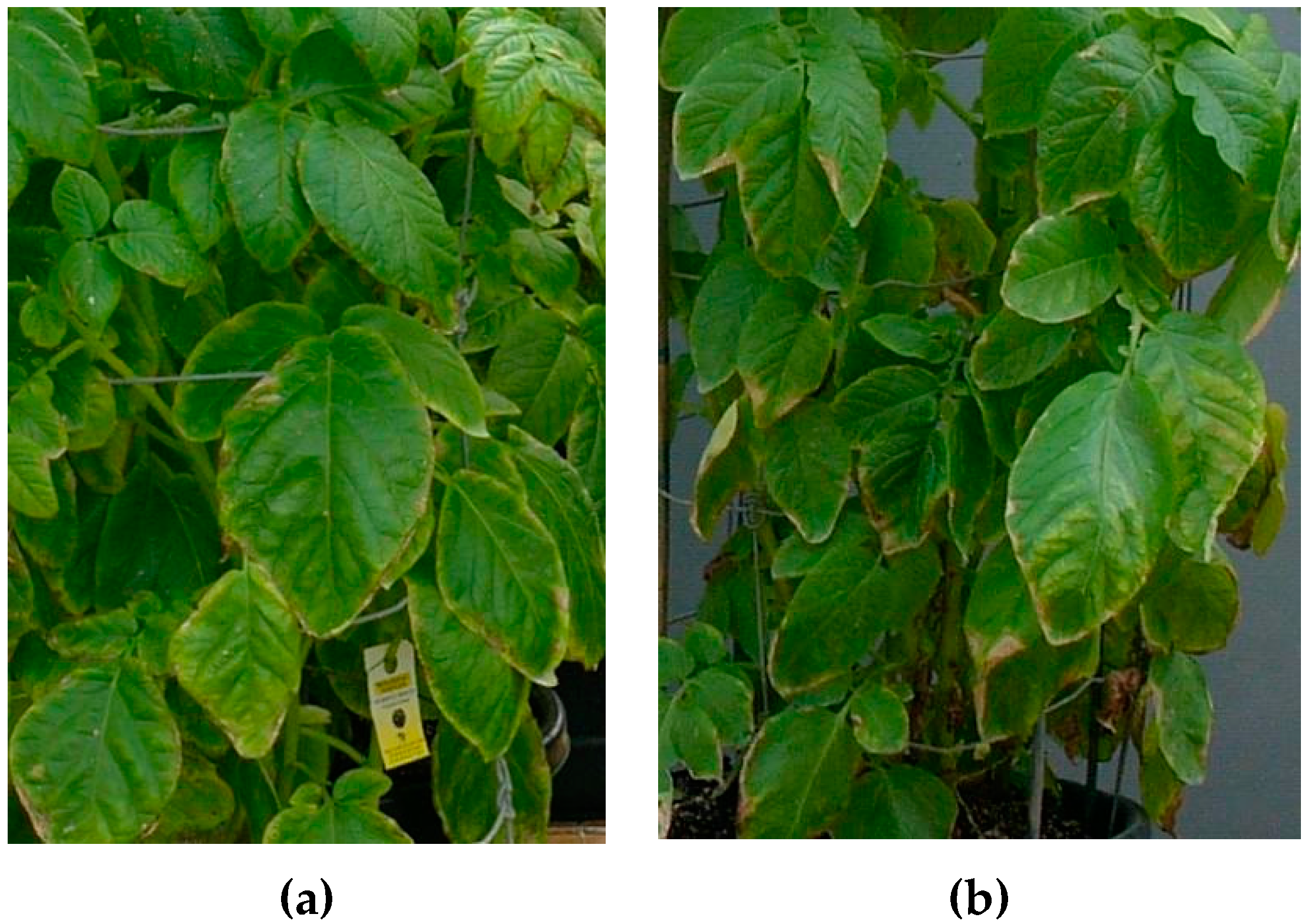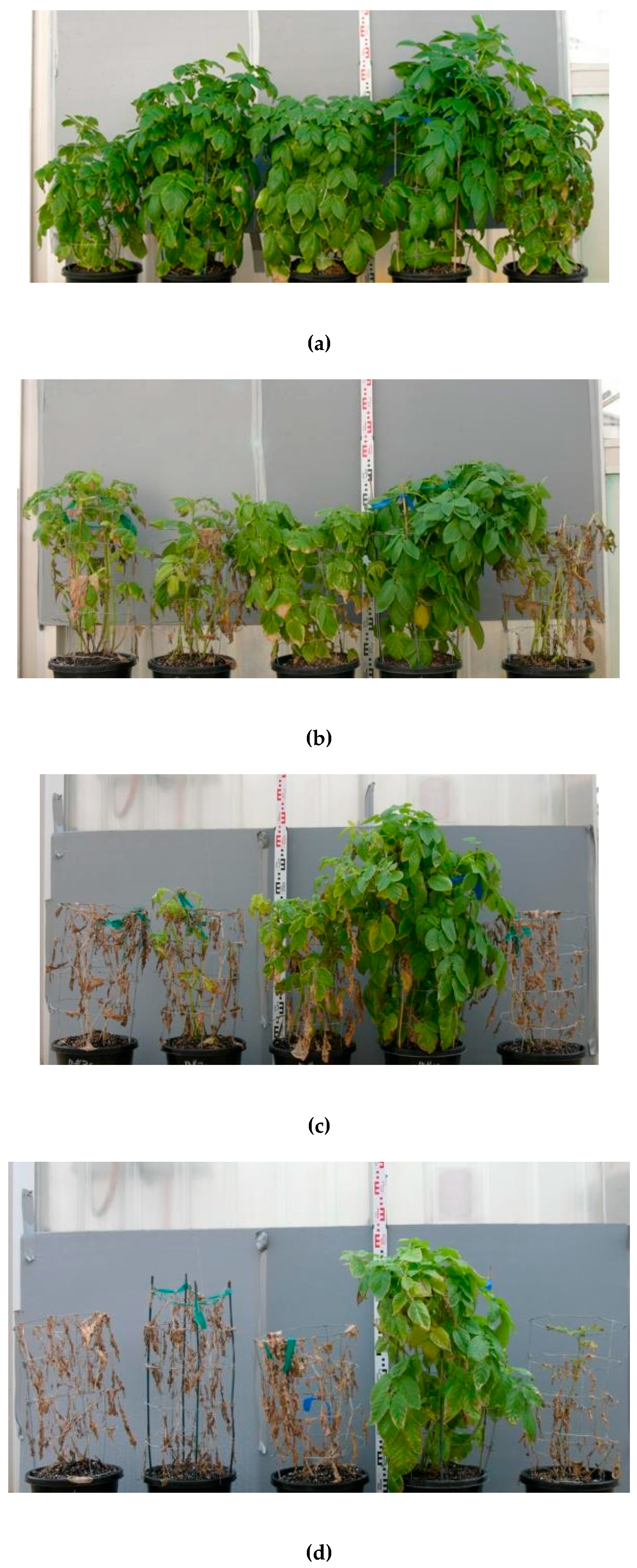A Short Non-Saline Sprinkling Increases the Tuber Weights of Saline Sprinkler Irrigated Potatoes
Abstract
:1. Introduction
2. Results
2.1. Irrigation and Drainage Waters
2.2. Plant Growth
2.3. Tissue Concentrations of Sodium and Chloride
3. Discussion
4. Materials and Methods
4.1. Materials and Culture
4.2. Trial Design and Analysis
4.3. Irrigation
4.4. Harvest and Tissue Analyses
5. Conclusions
Acknowledgments
Author Contributions
Conflicts of Interest
References
- Maas, E.V.; Hoffman, G.J. Crop salt tolerance—Current assessment. J. Irrig. Drain. Div. 1977, 103, 115–134. [Google Scholar]
- Bernstein, L.; Ayers, A.D.; Wadleigh, C.H. The salt tolerance of white rose potatoes. Proc. Am. Soc. Hortic. Sci. 1951, 57, 231–236. [Google Scholar]
- Bernstein, L.; Francois, L.E. Effects of frequency of sprinkling with saline waters compared with daily drip irrigation. Agron. J. 1975, 67, 185–190. [Google Scholar] [CrossRef]
- Benes, S.E.; Aragues, R.B.; Grattan, S.R. Brief pre- and post-irrigation sprinkling with freshwater reduces foliar salt uptake in maize and barley sprinkler irrigated with saline water. Plant Soil 1996, 180, 87–95. [Google Scholar] [CrossRef]
- National Water Commission. Emerging Trends in Desalination: A Review; National Water Commission: Canberra, Australia, 2008. [Google Scholar]
- Feldman, D.; Barbose, G.; Margolis, R.; Wiser, R.; Darghouth, N.; Goodrich, A. Photovoltaic (pv) Pricing Trends: Historical, Recent, and Near-Term Projections; U.S. Department of Energy: Oak Ridge, TN, USA, 2012.
- Stevens, R.M.; Pech, J.M.; Grigson, G.J. Improving yield of vegetables grown with over-canopy, saline irrigation. Acta Hortic. 2008, 792, 639–646. [Google Scholar] [CrossRef]
- Benes, S.E.; Aragues, R.; Grattan, S.R.; Austin, R.B. Foliar and root absorption of Na+ and Cl− in maize and barley: Implications for salt tolerance screening and the use of saline sprinkler irrigation. Plant Soil 1996, 180, 75–86. [Google Scholar] [CrossRef]
- Stevens, R.M.; Harvey, G.; Norton, S.; Frahn, W. Over-canopy saline sprinkler irrigation of grapevines during different growth stages. Agric. Water Manag. 2011, 101, 62–70. [Google Scholar] [CrossRef]
- Maas, E.V.; Grattan, S.R.; Ogata, G. Foliar salt accumulation and injury in crops sprinkled with saline water. Irrig. Sci. 1982, 3, 157–168. [Google Scholar] [CrossRef]
- United States Salinity Laboratory Staff. Diagnosis and Improvement of Saline and Alkali Soils; United States Department Agriculture Handbook No. 60.; U.S. Government Printing Office: Washington, DC, USA, 1954; pp. 1–160.
- James, R.A.; Munns, R.; von Caemmerer, S.; Trejo, C.; Miller, C.; Condon, T. Photosynthetic capacity is related to the cellular and subcellular partitioning of Na+, K+ and Cl− in salt-affected barley and durum wheat. Plant Cell Environ. 2006, 29, 2185–2197. [Google Scholar] [CrossRef] [PubMed]
- Rhoades, J.D. Drainage for salinity control. In Drainage for Agriculture; van Schilfgaarde, J., Ed.; American Society of Agronomy: Madison, WI, USA, 1974; Volume 17, pp. 433–468. [Google Scholar]
- Russo, V.M.; Karmarkar, S.V. Water extraction of plant tissues for analysis by ion chromatography. Commun. Soil Sci. Plant Anal. 1998, 29, 245–253. [Google Scholar] [CrossRef]
- Wheal, M.S.; Palmer, L.T. Chloride analysis of botanical samples by ICP-OES. J. Anal. At. Spectrom. 2010, 25, 1946–1952. [Google Scholar] [CrossRef]



| DAP | Irrigation Treatment | D | p-Value | ||||
|---|---|---|---|---|---|---|---|
| CONT | 85% SALT | SALT + 7.5%F | SALT + 15%F | SALT + 22.5%F | Means | ||
| Canopy dry weight | |||||||
| 65 | 38.6 ab | 25.4 de | 26.0 de | 32.4 bc | 30.1 cd | 30.5 | <0.001 (T) |
| 81 | 33.4 bc | 20.1 efg | 19.4 efgh | 20.6 efg | 24.9 de | 23.7 | <0.001 (D) |
| 92 | 41.4 a | 13.0 hi | 17.8 fghi | 16.6 fghi | 23.3 ef | 22.4 | 0.003 (T × D) |
| 103 | 34.2 bc | 11.7 i | 14.6 ghi | 17.3 fghi | 17.6 fghi | 19.1 | |
| T means | 36.9 | 17.6 | 19.4 | 21.7 | 24.0 | ||
| Wet weight of tubers | |||||||
| 65 | 624 cdef | 371 i | 439 fghi | 578 cdefgh | 499 efghi | 502 | <0.001 (T) |
| 81 | 843 b | 538 defghi | 490 efghi | 570 cdefgh | 626 cdef | 614 | <0.001 (D) |
| 92 | 1135 a | 395 hi | 611 cdefg | 596 cdefg | 723 bcd | 692 | 0.017 (T × D) |
| 103 | 1056 a | 429 ghi | 629 cde | 723 bcd | 738 bc | 715 | |
| T means | 914 | 433 | 542 | 617 | 647 | ||
| Tuber d.w. as % w.w. | |||||||
| 65 | 15.3 h | 15.6 gh | 16.1 cdefg | 15.9 efgh | 16.0 defgh | 15.8 | <0.001 (T) |
| 81 | 16.6 bcd | 16.1 cdefg | 16.0 defg | 16.6 bcde | 16.3 bcdef | 16.3 | <0.001 (D) |
| 92 | 17.8 a | 16.0 defg | 15.9 fgh | 16.7 bc | 16.9 b | 16.7 | <0.001 (T × D) |
| 103 | 18.1 a | 15.6 gh | 16.2 cdefg | 15.8 fgh | 16.1 cdefg | 16.3 | |
| T means | 17.0 | 15.8 | 16.0 | 16.3 | 16.3 | ||
| DAP | Irrigation Treatment | D | p-Value | ||||
|---|---|---|---|---|---|---|---|
| CONT | 85% SALT | SALT + 7.5%F | SALT + 15%F | SALT + 22.5%F | Means | ||
| Sodium | |||||||
| 43 | 117 e,* | 1215 bc | 1127 bcd | 844 cd | 746 d | 810 | <0.001 (T) |
| 74 | 172 e | 2197 a | 1885 a | 2189 a | 1240 bc | 1537 | <0.001 (D) |
| 92 | 271 e | 945 cd | 1385 b | 1235 bc | 1210 bc | 1009 | <0.001 (T × D) |
| T means | 187 | 1452 | 1466 | 1423 | 1065 | ||
| Chloride | |||||||
| 43 | 1069 | 2444 | 2378 | 2128 | 1949 | 1994 B | <0.001 (T) |
| 74 | 798 | 3364 | 3187 | 2763 | 2406 | 2503 A | <0.001 (D) |
| 92 | 455 | 1358 | 2218 | 1402 | 1086 | 1304 C | 0.108 (T × D) |
| T means | 774 d | 2388 ab | 2594 a | 2098 bc | 1814 c | ||
| Irrigation treatment | ||||||
|---|---|---|---|---|---|---|
| CONT | 85% SALT | SALT + 7.5%F | SALT + 15%F | SALT + 22.5%F | p-Value | |
| Sodium | 5 c,* | 43 a | 31 b | 36 ab | 32 b | <0.001 |
| Chloride | 71 d | 176 c | 225 a | 213 ab | 188 bc | <0.001 |
© 2017 by the authors. Licensee MDPI, Basel, Switzerland. This article is an open access article distributed under the terms and conditions of the Creative Commons Attribution (CC BY) license ( http://creativecommons.org/licenses/by/4.0/).
Share and Cite
Stevens, R.M.; Pech, J.M.; Grigson, G.J. A Short Non-Saline Sprinkling Increases the Tuber Weights of Saline Sprinkler Irrigated Potatoes. Agronomy 2017, 7, 4. https://doi.org/10.3390/agronomy7010004
Stevens RM, Pech JM, Grigson GJ. A Short Non-Saline Sprinkling Increases the Tuber Weights of Saline Sprinkler Irrigated Potatoes. Agronomy. 2017; 7(1):4. https://doi.org/10.3390/agronomy7010004
Chicago/Turabian StyleStevens, Rob M., Joanne M. Pech, and Gary J. Grigson. 2017. "A Short Non-Saline Sprinkling Increases the Tuber Weights of Saline Sprinkler Irrigated Potatoes" Agronomy 7, no. 1: 4. https://doi.org/10.3390/agronomy7010004
APA StyleStevens, R. M., Pech, J. M., & Grigson, G. J. (2017). A Short Non-Saline Sprinkling Increases the Tuber Weights of Saline Sprinkler Irrigated Potatoes. Agronomy, 7(1), 4. https://doi.org/10.3390/agronomy7010004





